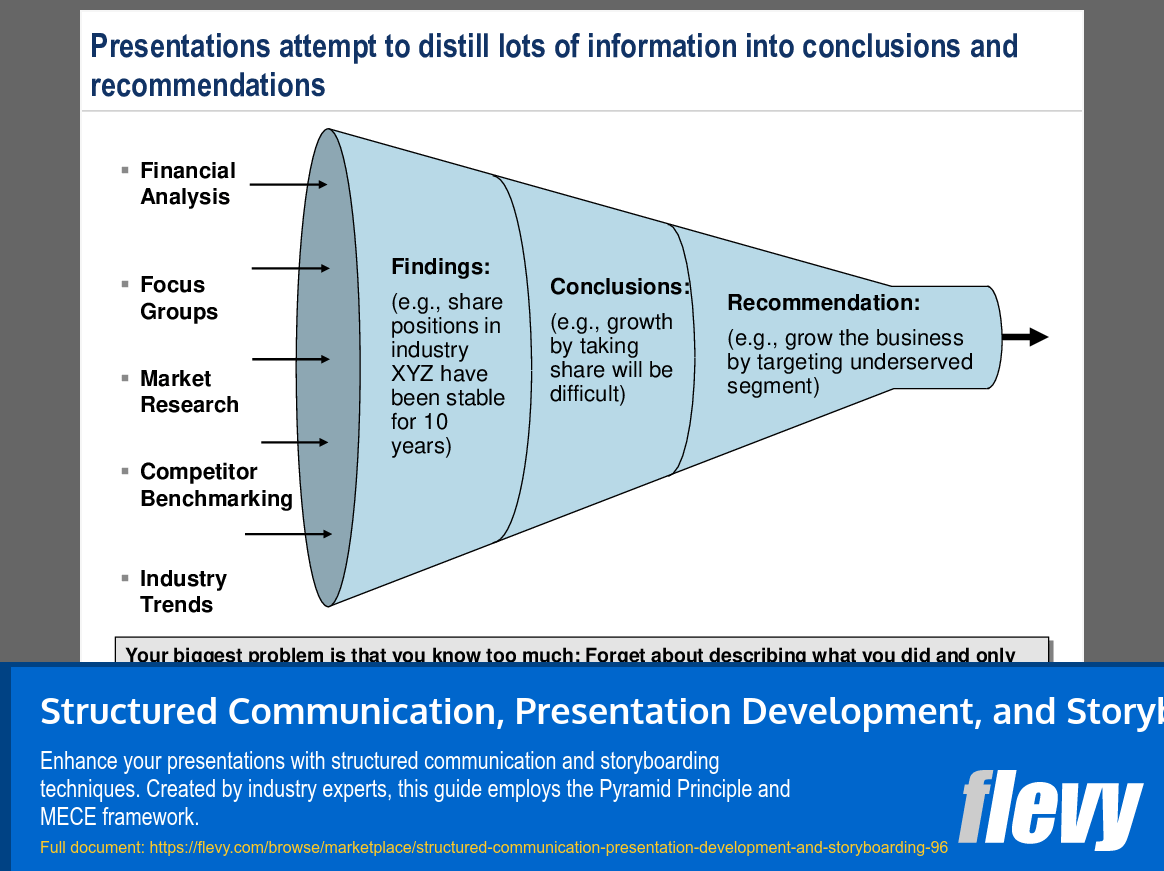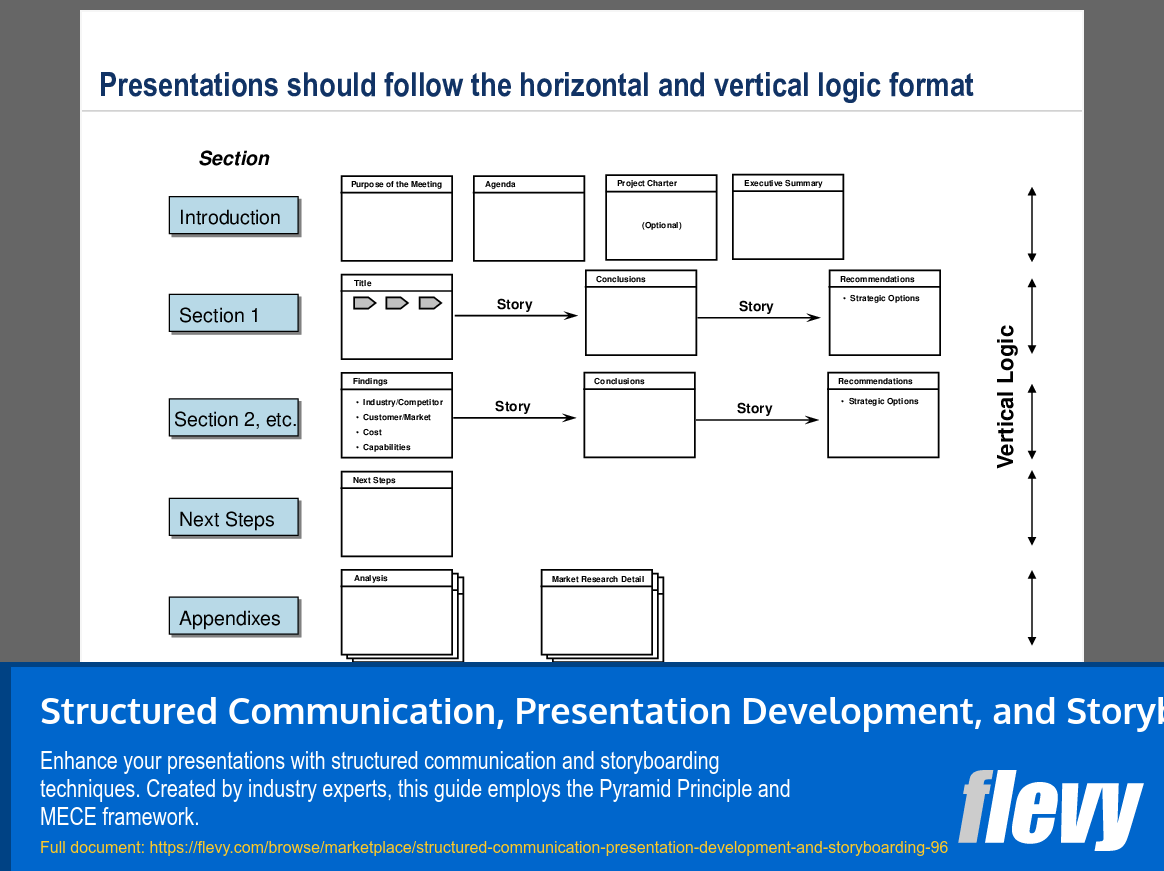The Fundamentals of Structured Communication, Presentation Development, and Storyboarding

This article discusses slides taken from a strategy consulting training presentation on Structured Communication, Presentation Development, and Storyboarding. You can download the full PPT here.
This presentation focuses on the essential elements of structured communication, specifically tailored for effective business presentations. It addresses how to formulate a clear and impactful message, emphasizing the need to define your objective, whether to inform or persuade, and adjusting your approach accordingly.
This subject matter is foundational to management consulting core skills — and, in fact, should be learned by professionals across all industries.
The core framework revolves around a systematic methodology for developing presentations, incorporating techniques like storyboarding and the Brown Paper method. These tools help organize content logically, ensuring that each section aligns with the overall objective. The presentation also highlights the Pyramid Principle and the MECE framework to enhance clarity and retention, ultimately guiding the audience through complex information efficiently.
Framework for Distilling Insights into Actionable Recommendations

The slide presents a structured method for transforming complex data into actionable insights using a funnel model. It outlines key data sources such as Financial Analysis, Focus Groups, Market Research, Competitor Benchmarking, and Industry Trends, which serve as foundational inputs for analysis. Each source plays a critical role in developing a comprehensive understanding of the market and the organization’s position within it.
In the center, the slide illustrates the progression from findings to conclusions and then to recommendations. Findings are specific observations, like the stability of market share, while conclusions highlight challenges, such as the difficulty in achieving growth through market share acquisition. Recommendations propose strategic actions, such as targeting underserved market segments to stimulate growth.
This framework underscores the necessity of clarity in presentations. It warns against the common mistake of overwhelming audiences with excessive detail, emphasizing the importance of distilling information into concise insights that facilitate decision-making. This approach not only enhances communication, but also aligns stakeholders on strategic priorities.
Read a more in-depth analysis of this PPT slide here.
Crafting Clear Communication Goals for Enhanced Audience Interaction

The slide outlines the critical need to establish clear communication objectives before addressing an audience. It identifies 3 main goals: to inform, to persuade, and to provoke action. Each objective plays a unique role in shaping the effectiveness of communication efforts.
The final goal, “to provoke action,” represents the ultimate aim of communication. Achieving this often involves first informing and persuading the audience, leading to actionable recommendations. This structured approach can significantly enhance the impact of presentations and audience engagement.
Read a more in-depth analysis of this PPT slide here.
Framework for Effective Presentation Storyboarding

The Brown Paper technique is a structured method for crafting presentations, focusing on clear organization and messaging. It begins with a cover sheet and agenda, laying the groundwork for the entire proposal. This initial setup ensures that all critical elements are addressed from the start.
Key messages for each chapter are formulated to maintain clarity and focus, supported by additional data or insights. The slide features a template that guides presenters through various components, including management summaries and project plans. This structured approach helps ensure that all relevant topics are thoroughly covered.
Verifying the storyline for coherence is crucial, with an emphasis on the MECE principle to avoid overlaps or gaps. The final step involves creating a succinct management summary that encapsulates the presentation. Overall, the Brown Paper technique serves as a valuable tool for enhancing communication effectiveness among executives.
Read a more in-depth analysis of this PPT slide here.
Understanding the Pyramid Structure in Communication

The slide presents a pyramid structure with 3 essential components: the key statement, vertical relationships, and horizontal relationships. At the apex is the key statement, which forms the foundation of the entire framework. This statement is bolstered by supporting arguments that adhere to the MECE principle, ensuring logical clarity in communication.
Vertical relationships are illustrated through a dynamic exchange of questions and answers, fostering engagement and guiding the audience through the content. This interaction is crucial for deepening the connection with the material. In contrast, horizontal relationships focus on constructing lines of argumentation, allowing for simultaneous presentation of supporting points, which enhances the overall persuasiveness of the message.
The visual representation emphasizes that effective communication requires a structured approach. Each element plays a critical role in making the message clear and compelling. This slide serves as a practical resource for executives aiming to refine their presentation skills through a systematic method of structuring ideas.
Read a more in-depth analysis of this PPT slide here.
Frameworks for Structuring Effective Argumentation

Effective communication relies on structured argumentation. This slide presents 3 frameworks for organizing ideas. The first, “Chronological,” outlines a sequential process in 3 steps, making it ideal for narratives that require a clear timeline. This approach helps the audience follow the logical progression of ideas.
The second framework, “Based on structure/category,” organizes information by breaking it down into its components, such as business units. This method clarifies complex subjects by highlighting specific structures. The third framework, “Based on relevance/significance,” categorizes findings by their impact, prompting presenters to consider what matters most to their audience.
These frameworks serve as a guide for structuring arguments effectively across different contexts. By applying them, executives can enhance their presentations, ensuring clarity and impact in their messaging.
Read a more in-depth analysis of this PPT slide here.
Identifying Gaps and Overlaps in Logic Trees

A logic tree serves as a tool for deconstructing complex issues into simpler parts. This slide highlights a failure to adhere to the MECE principle, which requires categories to be mutually exclusive and collectively exhaustive. The example shows how overlaps and gaps in categorization can lead to confusion in analysis.
The tree begins with “The world’s population,” branching into “People > 180 cm” and “People ≤ 180 cm.” However, the subsequent categories introduce ambiguity, as individuals can fit into multiple classifications, like a blue-eyed physicist. Such overlaps compromise the clarity of the analysis and hinder accurate conclusions.
This slide underscores the necessity for precise categorization in analytical frameworks. Understanding the MECE principle is vital for effective decision-making and communication, serving as a reminder to avoid redundancy and ensure comprehensive coverage of relevant aspects.
Read a more in-depth analysis of this PPT slide here.
Structured Presentation Framework for Effective Communication

The slide presents a structured framework for developing presentations, focusing on both horizontal and vertical logic. It starts with an “Introduction” that outlines the meeting’s purpose and agenda, followed by clearly defined sections that guide the flow of information. Each section, labeled sequentially, is designed to tell a cohesive story, categorizing findings into critical areas like industry insights, customer data, costs, and capabilities.
Key elements include “Conclusions” and “Recommendations,” which emphasize actionable insights derived from the presented findings. The slide also stresses the importance of outlining next steps to ensure continuity after the presentation. Appendices are mentioned as supplementary resources, allowing the main content to remain concise while offering deeper insights for those interested.
Read a more in-depth analysis of this PPT slide here.
Framework for Effective Introduction Communication

A well-structured introduction is essential for effective communication in business. The slide presents a framework that guides the audience from familiar concepts to insights gained through project analysis. It follows a logical progression: starting with the ‘Situation,’ then moving to ‘Complication,’ followed by ‘Question,’ and concluding with the ‘Answer’ or solution.
This structured approach emphasizes clarity and organization, crucial for presenting complex information. The visual representation, including a pyramid structure, reinforces the importance of guiding the audience through the narrative effectively.
Read a more in-depth analysis of this PPT slide here.
Distribution Channel Support Requirements Overview

The slide outlines the support requirements for various distribution channels, specifically siding distributors, retailers, and OEMs. It breaks down these needs into 6 categories: breadth of product line, delivery requirements, order processing, training by sales reps, financing, and packaging. Each category is visually represented with filled and unfilled circles to indicate the level of support required.
Siding distributors show a moderate need for a diverse product line and significant support in delivery and order processing, suggesting more complex logistics. Retailers require less breadth in product offerings and show lower needs in delivery and order processing, while OEMs fall somewhere in between. Training by sales reps is crucial for siding distributors, indicating they require deeper product knowledge compared to the other channels.
The varying levels of support for financing and packaging further highlight the distinct needs across these channels. This structured overview serves as a valuable tool for making informed decisions about resource allocation and channel management strategies.
